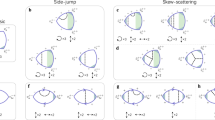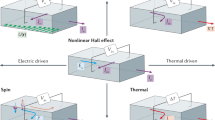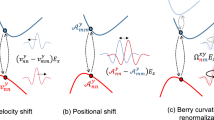Abstract
The electrical Hall effect is the production, upon the application of an electric field, of a transverse voltage under an out-of-plane magnetic field. Studies of the Hall effect have led to important breakthroughs, including the discoveries of Berry curvature and topological Chern invariants1,2. The internal magnetization of magnets means that the electrical Hall effect can occur in the absence of an external magnetic field2; this ‘anomalous’ Hall effect is important for the study of quantum magnets2,3,4,5,6,7. The electrical Hall effect has rarely been studied in non-magnetic materials without external magnetic fields, owing to the constraint of time-reversal symmetry. However, only in the linear response regime—when the Hall voltage is linearly proportional to the external electric field—does the Hall effect identically vanish as a result of time-reversal symmetry; the Hall effect in the nonlinear response regime is not subject to such symmetry constraints8,9,10. Here we report observations of the nonlinear Hall effect10 in electrical transport in bilayers of the non-magnetic quantum material WTe2 under time-reversal-symmetric conditions. We show that an electric current in bilayer WTe2 leads to a nonlinear Hall voltage in the absence of a magnetic field. The properties of this nonlinear Hall effect are distinct from those of the anomalous Hall effect in metals: the nonlinear Hall effect results in a quadratic, rather than linear, current–voltage characteristic and, in contrast to the anomalous Hall effect, the nonlinear Hall effect results in a much larger transverse than longitudinal voltage response, leading to a nonlinear Hall angle (the angle between the total voltage response and the applied electric field) of nearly 90 degrees. We further show that the nonlinear Hall effect provides a direct measure of the dipole moment10 of the Berry curvature, which arises from layer-polarized Dirac fermions in bilayer WTe2. Our results demonstrate a new type of Hall effect and provide a way of detecting Berry curvature in non-magnetic quantum materials.
This is a preview of subscription content, access via your institution
Access options
Access Nature and 54 other Nature Portfolio journals
Get Nature+, our best-value online-access subscription
$29.99 / 30 days
cancel any time
Subscribe to this journal
Receive 51 print issues and online access
$199.00 per year
only $3.90 per issue
Buy this article
- Purchase on Springer Link
- Instant access to full article PDF
Prices may be subject to local taxes which are calculated during checkout




Similar content being viewed by others
Data availability
The data shown in the plots and that support the other findings of this study are available from the corresponding authors on reasonable request.
References
Xiao, D., Chang, M.-C. & Niu, Q. Berry phase effects on electronic properties. Rev. Mod. Phys. 82, 1959–2007 (2010).
Nagaosa, N., Sinova, J., Onoda, S., MacDonald, A. & Ong, N. P. Anomalous Hall effect. Rev. Mod. Phys. 82, 1539–1592 (2010).
Chang, C.-Z. et al. Experimental observation of the quantum anomalous Hall effect in a magnetic topological insulator. Science 340, 167–170 (2013).
Binz, B. & Vishwanath, A. Chirality induced anomalous-Hall effect in helical spin crystals. Physica B 403, 1336–1340 (2008).
Nakatsuji, S., Kiyohara, N. & Higo, T. Large anomalous Hall effect in a non-collinear antiferromagnet at room temperature. Nature 527, 212–215 (2015).
Yasuda, K. et al. Geometric Hall effects in topological insulator heterostructures. Nat. Phys. 12, 555–559 (2016).
Liu, E. et al. Giant anomalous Hall effect in a ferromagnetic kagome-lattice semimetal. Nat. Phys. 14, 1125–1131 (2018).
Deyo, E., Golub, L., Ivchenko, E. & Spivak, B. Semiclassical theory of the photogalvanic effect in non-centrosymmetric systems. Preprint at https://arxiv.org/abs/0904.1917 (2009).
Moore, J. E. & Orenstein, J. Confinement-induced Berry phase and helicity-dependent photocurrents. Phys. Rev. Lett. 105, 026805 (2010).
Sodemann, I. & Fu, L. Quantum nonlinear Hall effect induced by Berry curvature dipole in time-reversal invariant materials. Phys. Rev. Lett. 115, 216806 (2015).
Lee, J., Wang, Z., Xie, H., Mak, K. F. & Shan, J. Valley magnetoelectricity in single-layer MoS2. Nat. Mater. 16, 887–891 (2017).
Xu, S.-Y. et al. Electrically switchable Berry curvature dipole in the monolayer topological insulator WTe2. Nat. Phys. 14, 900–906 (2018).
Low, T., Jiang, Y. & Guinea, F. Topological currents in black phosphorus with broken inversion symmetry. Phys. Rev. B 92, 235447 (2015).
Morimoto, T. & Nagaosa, N. Chiral anomaly and giant magnetochiral anisotropy in noncentrosymmetric Weyl semimetals. Phys. Rev. Lett. 117, 146603 (2016).
Zhang, Y., Sun, Y. & Yan, B. The Berry curvature dipole in Weyl semimetal materials: an ab initio study. Phys. Rev. B 97, 041101(R) (2018).
Tsirkin, S. S., Puente, P. A. & Souza, I. Gyrotropic effects in trigonal tellurium studied from first principles. Phys. Rev. B 97, 035158 (2018).
Zhang, Y., Brink, J. V. d., Felser, C. & Yan, B. Electrically tuneable nonlinear anomalous Hall effect in two-dimensional transition-metal dichalcogenides WTe2 and MoTe2. 2D Materials 5, 044001 (2018).
You, J.-S., Fang, S., Xu, S.-Y., Kaxiras, E. & Low, T. The Berry curvature dipole current in transition metal dichalcogenides family. Phys. Rev. B 98, 121109(R) (2018).
Shi, L.-k. & Song, J. C. W. Berry curvature switch and magneto-electric effect in WTe2 monolayer. Preprint at https://arxiv.org/abs/1805.00939 (2018).
Facio, J. I. et al. Giant enhancement of Berry-dipole at topological phase transitions in BiTeI. Preprint at https://arxiv.org/abs/1805.02680 (2018).
Ali, M. N. et al. Large, non-saturating magnetoresistance in WTe2. Nature 514, 205–208 (2014).
Soluyanov, A. et al. Type-II Weyl semimetals. Nature 527, 495–498 (2015).
Qian, X., Liu, J., Fu, L. & Li, J. Quantum spin Hall effect in two-dimensional transition metal dichalcogenides. Science 346, 1344–1347 (2014).
MacNeill, D. et al. Control of spin-orbit torques through crystal symmetry in WTe2/ferromagnet bilayers. Nat. Phys. 13, 300–305 (2016).
Fei, Z. et al. Edge conduction in monolayer WTe2. Nat. Phys. 13, 677–682 (2017).
Tang, S. et al. Quantum spin Hall state in monolayer 1T′-WTe2. Nat. Phys. 13, 683–687 (2017).
Wu, S. et al. Observation of the quantum spin Hall effect up to 100 Kelvin in a monolayer crystal. Science 359, 76–79 (2018).
Fatemi, V. et al. Electrically tunable low density superconductivity in a monolayer topological insulator. Science 362, 926–929 (2018).
Sajadi, E. et al. Gate-induced superconductivity in a monolayer topological insulator. Science 362 922–925 (2018).
Fei, Z. et al. Ferroelectric switching of a two-dimensional metal. Nature 560, 336–339 (2018).
Mak, K. F., McGill, K. L., Park, J. & McEuen, P. L. The valley Hall effect in MoS2 transistors. Science 344, 1489–1492 (2014).
Qin, F. et al. Superconductivity in a chiral nanotube. Nat. Commun. 8, 14465 (2017).
Harter, J., Zhao, Z., Yan, J.-Q., Mandrus, D. & Hsieh, D. A parity-breaking electronic nematic phase transition in the spin-orbit coupled metal Cd2Re2O7. Science 356, 295–299 (2017).
Mar, A., Jobic, S. & Ibers, J. A. Metal-metal vs tellurium-tellurium bonding in WTe2 and its ternary variants TaIrTe4 and NbIrTe4. J. Am. Chem. Soc. 114, 8963–8971 (1992).
Beams, R. et al. Characterization of few-layer 1T′ MoTe2 by polarization-resolved second harmonic generation and Raman scattering. ACS Nano 10, 9626–9636 (2016).
Taychatanapat, T. & Jarillo-Herrero, P. Electronic transport in dual-gated bilayer graphene at large displacement fields. Phys. Rev. Lett. 105, 166601 (2010).
Golub, L. E. & Ivchenko, E. L. Circular and magnetoinduced photocurrents in Weyl semimetals. Phys. Rev. B 98, 075305 (2018).
Ideue, T. et al. Bulk rectification effect in a polar semiconductor. Nat. Phys. 13, 578–583 (2017).
Wakatsuki, R. et al. Nonreciprocal charge transport in noncentrosymmetric superconductors. Sci. Adv. 3, e1602390 (2017).
Sinova, J., Valenzuela, S. O., Wunderlich, J., Back, C. & Jungwirth, T. Spin Hall effects. Rev. Mod. Phys. 87, 1213–1260 (2015).
Kim, J. et al. Layer thickness dependence of the current-induced effective field vector in Ta|CoFeB|MgO. Nat. Mater. 12, 240–245 (2013).
Garello, K. et al. Symmetry and magnitude of spin-orbit torques in ferromagnetic heterostructures. Nat. Nanotechnol. 8, 587–593 (2013).
MacNeill, D. et al. Thickness dependence of spin-orbit torques generated by WTe2. Phys. Rev. B 96, 054450 (2017).
Yao, W., Xiao, D. & Niu, Q. Valley-dependent optoelectronics from inversion symmetry breaking. Phys. Rev. B 77, 235406 (2008).
Perdew, J. P., Burke, K. & Ernzerhof, M. Generalized gradient approximation made simple. Phys. Rev. Lett. 77, 3865–3868 (1996).
Kresse, G. & Furthmüller, J. Efficient iterative schemes for ab initio total-energy calculations using a plane-wave basis set. Phys. Rev. B 54, 11169–11186 (1996).
Heyd, J., Scuseria, G. E. & Ernzerhof, M. Hybrid functionals based on a screened Coulomb potential. J. Chem. Phys. 118, 8207–8215 (2003).
Zheng, F. et al. On the quantum spin Hall gap of monolayer 1T′-WTe2. Adv. Mater. 28, 4845–4851 (2016).
Souza, I., Marzari, N. & Vanderbilt, D. Maximally localized Wannier functions for entangled energy bands. Phys. Rev. B 65, 035109 (2001).
Muechler, L., Alexandradinata, A., Neupert, T. & Car, R. Topological nonsymmorphic metals from band inversion. Phys. Rev. X 6, 041069 (2016).
Acknowledgements
We thank J. Checkelsky, F. Qin, Y. Iwasa, J.-S. You and I. Sodemann for discussions. Work in the PJH group was supported partly by the Center for Excitonics, an Energy Frontier Research Center funded by the US Department of Energy (DOE), Office of Science, Office of Basic Energy Sciences (BES) under award number DESC0001088 (fabrication and measurement) and partly through AFOSR grant FA9550-16-1-0382 (data analysis), and by the Gordon and Betty Moore Foundation’s EPiQS Initiative through grant GBMF4541 to P.J.-H. This work made use of the Materials Research Science and Engineering Center Shared Experimental Facilities supported by the National Science Foundation (NSF; grant number DMR-0819762). N.G. and S.-Y.X. acknowledge support from DOE, BES DMSE (data taking and analysis), the Gordon and Betty Moore Foundations EPiQS Initiative through grant GBMF4540 (manuscript writing) and NSF grant number DMR-1809815 (modelling). The WTe2 crystal growth performed at Princeton University was supported by NSF MRSEC grant DMR-1420541 (Q.D.G. and R.J.C.). Z.D. and H.-Z.L. were supported by the Guangdong Innovative and Entrepreneurial Research Team Program (2016ZT06D348), the National Key R&D Program (2016YFA0301700), the National Natural Science Foundation of China (11574127), and the Science, Technology, and Innovation Commission of Shenzhen Municipality (ZDSYS20170303165926217 and JCYJ20170412152620376). K.W. and T.T. acknowledge support from the Elemental Strategy Initiative conducted by MEXT, Japan, JSPS KAKENHI grant numbers JP18K19136 and CREST (JPMJCR15F3), JST. H.S., L.F. and S.F. acknowledge support from NSF Science and Technology Center for Integrated Quantum Materials grant DMR-1231319 (theory for H.S. and L.F.; calculations for S.F.). H.L. acknowledges Academia Sinica, Taiwan, for support under Innovative Materials and Analysis Technology Exploration (AS-iMATE-107-11). T.-R.C. was supported by the Young Scholar Fellowship Program by Ministry of Science and Technology (MOST) in Taiwan, under MOST Grant for the Columbus Program MOST107-2636-M-006-004, National Cheng Kung University, Taiwan, and National Center for Theoretical Sciences (NCTS), Taiwan. E.K. acknowledges support by ARO MURI Award W911NF-14-0247. The computational work at Harvard University was performed on the Odyssey cluster, which is supported by the FAS Division of Science, Research Computing Group.
Reviewer information
Nature thanks J. van den Brink and the other anonymous reviewer(s) for their contribution to the peer review of this work.
Author information
Authors and Affiliations
Contributions
P.J.-H. and N.G. supervised the project. S.-Y.X. and Q.M. conceived the experiment, performed the photocurrent measurements and analysed the data. Q.M., S.-Y.X. and D.M. performed the transport measurements with help from V.F., and all performed data analysis and discussed the results. A.M.M.V., Q.M., D.M., S.W. and V.F. fabricated the devices. T.-R.C., C.-H.H. and S.F. calculated the first-principles band structures and the Berry-curvature dipole in bilayer WTe2 under the supervision of E.K. and H.L. H.S., S.-Y.X. and Z.D. performed the theoretical modelling and analyses under the supervision of H.-Z.L. and L.F. Q.D.G. and R.J.C. grew the bulk WTe2 single crystals. K.W. and T.T. grew the bulk hexagonal boron nitride single crystals. S.-Y.X., Q.M., N.G. and P.J.-H. wrote the manuscript, with input from all authors.
Corresponding authors
Ethics declarations
Competing interests
The authors declare no competing interests.
Additional information
Publisher’s note: Springer Nature remains neutral with regard to jurisdictional claims in published maps and institutional affiliations.
Extended data figures and tables
Extended Data Fig. 1 Asymmetric inter-layer coupling.
a, b, In monolayer WTe2 (a), the low-energy physics is characterized by a W 5d band and a Te 5p band (b). Owing to the band inversion near the Γ point, a Dirac fermion is formed at the Q (Q′) point. Without spin–orbit coupling (SOC), the Dirac fermion is gapless because of the inversion symmetry of the 1T′ crystal structure50. The inclusion of spin–orbit coupling opens up a gap, leading to a quantum spin Hall state. c–e, Bilayer WTe2 (c) is described by a pair of Dirac fermions at the Q point, which consist of four bands (d). To isolate the underlying mechanism for the resistance (Rxx) behaviour (e), we ignore the wavevector k and look at only the Γ point. The four bands simplify into four energy levels: the W 5d band in layer 1 (W-L1), the W 5d band in layer2 (W-L2), the Te 5p band in layer 1 (Te-L1) and the Te 5p band in layer 2 (Te-L2). Owing to the asymmetric inter-layer coupling, orbitals from opposite layers gain different on-site potentials, which lifts the layer degeneracy. This coupling is allowed only when the system lacks any symmetry that relates c to −c (Supplementary Information section II.4). An external D field along one direction enhances the layer splitting, whereas a D field along the opposite direction reduces and eventually reverses the splitting. The data in e can be explained by correlating the resistance with the global bandgap in d. The asymmetric-coupling mechanism is confirmed by our first-principles calculation (Extended Data Fig. 2). EF, Fermi energy.
Extended Data Fig. 2 Band structure of bilayer WTe2 as a function of the external electric field.
a–d, With positive E fields, the global bandgap increases then decreases; with negative E fields, the global bandgap decreases. The evolution of the valence-band splitting at the Γ point (black arrows) of the global bandgap as a function of the E field are consistent with the picture in Extended Data Fig. 1. The green circle in d highlights the anti-crossing (a massive Dirac fermion) formed between the lowest two conduction bands at D > 0. Such a massive Dirac cone with a small gap (approximately 3 meV) leads to large Berry curvature near the gap edges, which is responsible for the additional sharp features in the \({V}_{baa}^{2\omega }\) data (Supplementary Information section V).
Extended Data Fig. 3 Gate and temperature dependence of the nonlinear Hall voltage and resistance.
a, Gate map of \({V}_{baa}^{2\omega }\). b, Temperature dependence of \({V}_{baa}^{2\omega }\) as a function of VB at VT = −5 V (green dashed line in a). c, Same as b, but for the resistance R. The diagonal black dashed line in a traces the maximum of the resistance as a function of VT and VB; the black dashed lines in b and c trace the resistance maximum at different temperatures.
Supplementary information
Supplementary Information
This file contains: I. Crystal structure of bilayer WTe2 and its connection to Berry curvature dipole; II. Additional transport data; III. Additional photocurrent data; IV. Symmetry analysis of the circular photogalvanic effect; V. First-principles calculated band structures and Berry curvature dipoles; VI. Full physical picture for the Berry curvature dipole in bilayer WTe2; VII. Obtaining Berry curvature dipole \({\Lambda }_{a}\) from \({V}_{baa}^{2\omega }\) data; VIII. Other second-order transport effects; IX. Responsivity of the nonlinear Hall effect; X. Appendix.
Rights and permissions
About this article
Cite this article
Ma, Q., Xu, SY., Shen, H. et al. Observation of the nonlinear Hall effect under time-reversal-symmetric conditions. Nature 565, 337–342 (2019). https://doi.org/10.1038/s41586-018-0807-6
Received:
Accepted:
Published:
Issue Date:
DOI: https://doi.org/10.1038/s41586-018-0807-6
This article is cited by
-
Real space characterization of nonlinear hall effect in confined directions
npj Computational Materials (2024)
-
Room-temperature flexible manipulation of the quantum-metric structure in a topological chiral antiferromagnet
Nature Physics (2024)
-
Angle-resolved transport non-reciprocity and spontaneous symmetry breaking in twisted trilayer graphene
Nature Materials (2024)
-
Interfacial magnetic spin Hall effect in van der Waals Fe3GeTe2/MoTe2 heterostructure
Nature Communications (2024)
-
A tunable room-temperature nonlinear Hall effect in elemental bismuth thin films
Nature Electronics (2024)
Comments
By submitting a comment you agree to abide by our Terms and Community Guidelines. If you find something abusive or that does not comply with our terms or guidelines please flag it as inappropriate.



